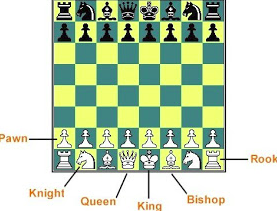Chess is a game of strategy and war played by two players, each controlling an army of two different colours, pale and darker colour usually white and black.
The pieces on each side:
- King (1)
- Queen (1)
- Rook (2)
- Knight (2)
- Bishop (2)
- Pawn (8)

Rules
- White square is always on the right hand corner of each side.
- The queen stands on its own colour.
- White always makes the first move at the beginning of the game.
- Checkmate the opponent’s king is the ultimate aim in a chess game.
- The king is always the tallest piece with a small cross on the top of its crown in most chess sets. It usually moves one square at a time in any direction. There is one special move or leap for the king and it is called castling, where the king and rook can leave their starting squares on the same turn. You can castle on both sides of the board, short castling is to move the king two squares to the right and move the rook two squares to the left. Long castling is the Queen side castling where the king moves two squares to the left and the rook moves three squares to the right. The rules of castling are: (1) you cannot castle if your king has already moved, (2) you cannot castle if your rook has already moved, (3) you cannot castle if your king is in check on that turn, (4) you cannot castle if your king lands into a check, (5) you cannot castle if there is a piece standing in the way of the king or rook.
- The queen can move up and down and across the board, as well as the diagonals in any direction and square as long as there is nothing blocking its path.
- The rook can move up and down, side to side on the board unless there is something blocking its path. They cannot leap unless it is performing the special move of castling.
- The knight moves two squares in a straight direction and then one to the side, either to the left or right, like an L shape.
- The bishop moves forwards or backwards along the diagonals for as many squares as it likes, as long as there is nothing standing in its way. Both bishops run only move along in their respective colour of square. They must keep to their colour of square.
- The pawn can move either one or two squares forward in their first move. They cannot move backward or sideway. It can only capture an enemy’s piece by moving one square diagonally forward. If a pawn reaches the other side of the board it must immediately transform into another piece (queen, rook, knight or bishop) of your choice. The pawn can make a special move as well and it is called en passant. The en passant capture is available only when a pawn advances two squares from its starting position on a file adjacent to an enemy pawn. It must be captured on the turn immediately or the option disappears.
